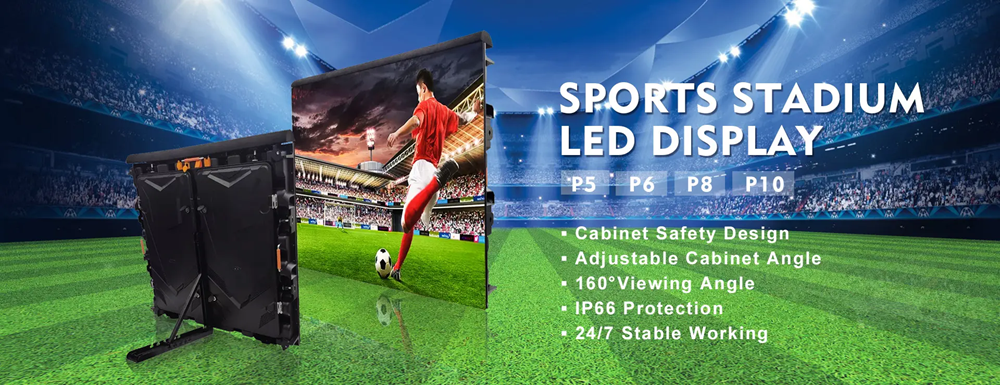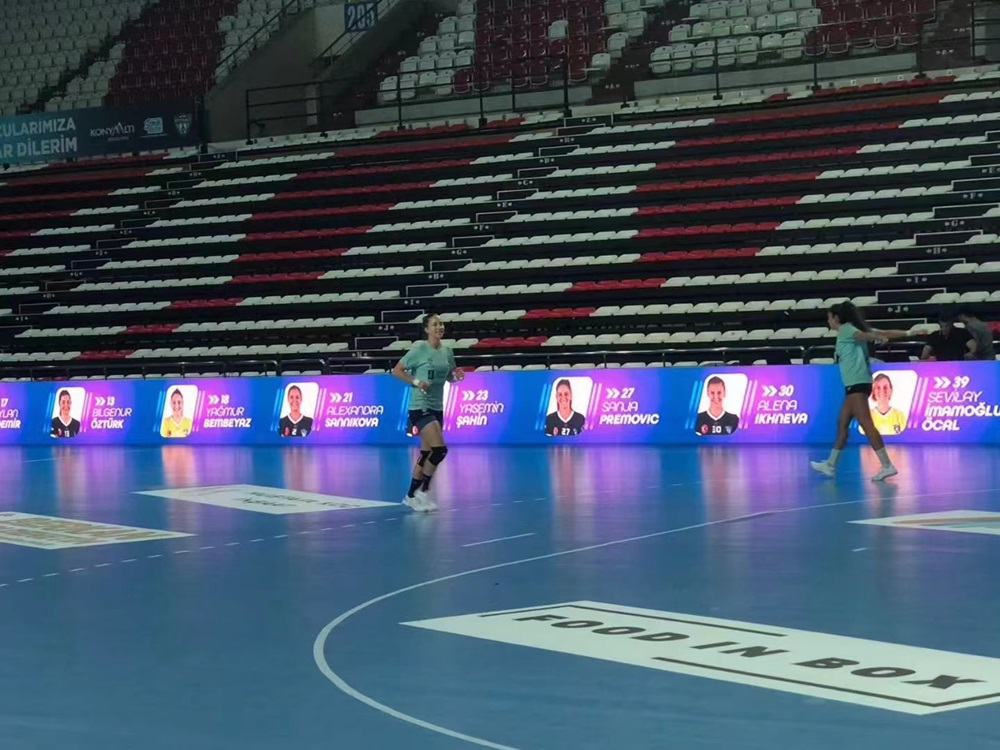Stadium LED screens are increasingly used to display images at sports events. They entertain the audience, broadcast information, and provide an unforgettable experience for viewers. If you’re considering installing one in a stadium or arena, you’re in the right place! Here’s everything you need to know about choosing a stadium LED screen: how they have evolved over time, the types of content they can display, the best technology for outdoor viewing, why pixel pitch is important when selecting an LED or LCD screen, and more.
Why Do Stadiums Need Screens?
If you own a football stadium, you likely understand the importance of a display screen. Whether you need it to show live video, advertisements, or footage from another stadium, there’s no better way to communicate than with a high-quality display visible to everyone in the stands. Here are the benefits of using a display screen in a stadium:
Longer Lifespan
Stadium screens have a longer lifespan and higher usage frequency compared to traditional scoreboards. The average lifespan of an LCD or LED display is about 25,000 hours (approximately 8 years). This means its typical usage life will far exceed the duration of any game in the stadium!
Displays are not easily affected by weather conditions like rain, snow, or sunlight, as they can withstand these environmental factors. They may need some adjustments to maintain brightness during rain, but this is usually not an issue.
Energy Efficiency
Stadium screens can also save electricity. This means they can reduce the stadium’s power consumption, saving you money in the long run. They even help lower energy costs and allow you to turn off or dim any other traditional lighting forms in the stadium, including spotlights on signs, security lights around seating areas, and decorative indoor lighting throughout the venue.
The screens use LED backlighting, which consumes much less power than LCD panels (which need constant refreshing). Think about how many hours these screens run each day without LED when you get your next electricity bill!
Programmable Lighting Control
Displays also offer built-in programmable lighting controls that can be used to create a unique atmosphere in your stadium. This means you can change its appearance based on the ongoing game, even during halftime or other breaks between matches!
LED screens allow various preset lighting effects, such as smooth transitions between colors, flashing lights, strobe effects (like lightning), fade-ins/outs, etc. This can make your display truly stand out, providing an unforgettable experience for fans of all ages!
Today, many applications can help you remotely control these functions via WiFi, which is very useful if you’re not near the venue when making changes!
More Professional and Stylish
Display screens can give your stadium a more professional and stylish appearance. The large size and high-quality images help create an overall feeling distinctly different from using traditional scoreboards (such as flip boards or blackboards).
A good example of this difference is comparing LED and LCD displays: LED screens are usually larger due to their higher resolution, allowing them to display clear, detailed text and graphics like logos; whereas LCD panels have lower resolution and might cause blurry text or distorted videos if not sized correctly.
Additional Advertising Opportunities
Display screens can also serve as another way to advertise. You’ll find that stadium screens are often prime space for advertisers, which is why you see all the ads on TV during major sports events like the World Cup or Olympics. But note that if your venue has any restrictions on sponsorships, only certain ads may be allowed there – but it’s still a great opportunity!
In terms of efficiency and cost savings, it offers more benefits than using stadium-dominant screen boards, so make sure to consider these factors when choosing your next screen board!
History of Stadium LED Screens
A company called Jumbotron was one of the first to sell stadium LED screens. It was 1985, and they were looking for a way to make their products more competitive in an already crowded market – but that’s when LED displays really began to take off! This led to some significant changes that still affect how these screens are designed today:
Due to the large audience viewing from afar, high-capacity stadiums need higher resolution, while smaller venues are suitable for lower-resolution panels, as it would already be very difficult to see what’s happening on the screen if further limited (like blurriness).
In 1993, the Digital HDTV Consortium introduced HDTV technology on newly installed digital scoreboards in the US.
The next major change was using LCD technology instead of traditional LED screens for stadiums. This allowed for higher resolutions, making it easier for the audience to watch and improving viewing angles – meaning less distortion even when viewed from odd angles! But this meant the display boards were no longer limited to 4 feet wide, as they could be larger without sacrificing quality (like 160 inches)! Since then, this has been one of the biggest changes when designing these boards.
What to Consider When Choosing a Stadium LED Screen
There are many aspects to consider when choosing a stadium LED screen. These aspects include:
Energy Efficiency and Brightness Contrast
When considering a stadium LED screen, it’s important to think about energy efficiency and brightness contrast.
The entire purpose of these displays is to let people see what’s happening – if they can’t see, it’s pointless! A screen that’s too dark or too bright is not helpful to anyone, as it can even harm viewers in some cases (e.g., people with epilepsy).
Therefore, you need a display that covers the entire spectrum (e.g., warm light) and has optimal brightness contrast to ensure everything on the screen is clearly visible without being overly distracting.
Installation Options
If you’re investing in a stadium LED screen, it must be properly installed so that all viewers can see the display correctly. These screens range from 8 feet to 160 inches wide, with four different installation options depending on the size of your venue (e.g., if your space is small, wall-mounted might be the best choice).
For larger venues with more available space, you can opt to install it as a floor or ceiling-mounted screen, achieving higher resolution as it is set at eye level rather than below ground! However, these do require some extra work when it comes to mounting brackets and such, whereas low-profile – like one inch high – does not require extra work.
Viewing Distance and Angle
When it comes to stadium LED screens, you need to consider the required viewing distance and angle.
For example, if your venue has many seats in the back rows, you might not need a high-resolution large screen because it won’t be very clear from such a distance! More importantly, this means viewers in the back row will have a great viewing experience without any interference or distortion, which might occur when watching on smaller screens – even 4 feet wide large screens.
However, if you are seeking higher resolution due to space limitations, low-profile displays might be the best fit where security is not a major concern.
Screen Protection
In the past, stadium screens were easily damaged due to wear and tear from everyday use. However, recent technological advancements have made these displays harder to scratch or break – so screen protection is no longer an issue! This doesn’t mean you can completely avoid this problem, although it’s still possible if your venue space is limited.
Some possible methods to protect the display include: using caution tape or protective film on the surrounding environment (e.g., surrounding walls), adding extra layers (like bubble wrap, etc.); but also being careful when cleaning with liquid cleaners as this can cause water-related marks to remain on the board.
Which Is More Suitable for Outdoor Viewing, LED or LCD?
This might depend on your venue and what you need to display.
LED screens are brighter, more colorful, and higher resolution than LCDs, making them perfect for those who want clearer images. But LED requires less power, saving money in the long run!
However, LCDs have advantages for outdoor use because their backlight can be turned off (whereas LEDs cannot), which might be important if you’re not using them at night or in cloudy conditions. They also have higher contrast, which is crucial for people with poor eyesight as it improves text visibility by increasing the brightness difference between foreground and background images/textures.
How to Choose the Right Pixel Pitch for Stadium LED Screens?
The pixel pitch of a display plays a crucial role in the clarity and sharpness of images on the screen, but it also depends on other factors like viewing distance, resolution, etc. For example, if you are looking for an outdoor display, there is no point in spending money on a high-resolution display because it won’t be visible from a distance! Therefore, you need to consider this when choosing the stadium LED screen you need.
Conclusion
There are many things to consider when choosing the right Stadium Perimeter LED Display, such as viewing distance and angle, installation options, viewing quality, etc. However, if you are unsure which type of display is best for your venue, don’t worry because hopefully, this blog post provides some key points on how to make an informed choice.
Post time: Jul-23-2024


